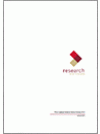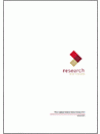This report outlines the results of the TELA Laptops Scheme School Survey for 2013. This survey was conducted in order to determine whether the current products offered by the TELA Scheme are meeting user needs and to examine the quality of support services schools receive from Telecom Rental.
Methodology
During November 2013 a total sample of n=1,000 schools who are currently on the TELA Scheme were invited to complete the survey; at least one user in n=752 schools did so1. This represents a school participation rate of 75 percent. In total, across the n=752 participating schools, n=1,130 TELA laptop users and in-school TELA contact persons participated in the survey.
Key Results
The main findings are summarised below in relation to the two main objectives of the survey. Table 1 and Table 2 summarise these main findings.
Are the current products offered by the TELA Scheme meeting user needs?
Responding teachers and principals, in both primary and secondary schools, stated they used their TELA laptop for a range of different uses to assist them with their teaching and/or management of their school. For example, primary school teachers stated they use their laptop to complete internet searchers (99 percent), send and receive emails (98 percent), prepare student reports/assessments (98 percent), plan lessons (95 percent), etc. Over onehalf of users also said they used their laptop for personal use (between 55 percent and 65 percent).
The large majority of responding teachers and principals with a TELA laptop, in both primary and secondary schools, rated the reliability and ease of use of their TELA laptop very high (between 86 percent and 96 percent). In fact, over two-thirds gave their TELA laptop the highest possible rating for reliability and ease of use (i.e., a rating of 5 on the five-point rating scale).
As a result, the large majority of responding teachers and principals, in both primary and secondary schools, also rated their overall satisfaction with their TELA laptop in positive terms (between 84 percent and 89 percent). Fifty-percent or more gave the highest possible rating of satisfaction (rating of 5 on the five-point rating scale).
The positive view of users of TELA laptops were, in turn, reflected in the positive opinions of TELA support staff within schools.Against this background, it should be noted that the majority of responding teachers and principals in both primary and secondary schools stated they supplemented the use of their TELA laptop with non-TELA devices. In this regard, tablets were the device most frequently mentioned. For example, 64 percent of those teachers and principals with an Apple TELA laptop also used a tablet. This most probably reflects the compatibility of the devices, rather than the fact that the Apple TELA laptop is deficient in some respect.As a result, when responding teachers and principals were asked whether tablets and hybrid laptops should be made available through the TELA Scheme, significant percentages of respondents in both primary and secondary schools (between 36 percent and 44 percent) stated that tablets ‘to a large extent’ would improve the work that they do. This was less likely to be the case with regard to hybrid laptops.There is also an expectation amongst responding teachers and principals in both primary and secondary schools that their TELA needs will change as a result of Ultra-Fast Broadband (UFB) and the Rural Broadband Initiative (RBI). In fact, between 24 percent and 39 percent of teachers and principals expected their needs would change. Most of these respondents expect their school will need to upgrade their ICT equipment and update their devices in order to take full advantage of the enhanced connectivity UFB and the RBI will provide.
Related to this is the fact that when responding teachers and principals were asked what the biggest teaching challenges in relation to digital technology were, a large percentage of principals stated it was cost, while teachers and principals were likely to say it was the challenge of up skilling staff.
What is the quality of the support services received by schools from Telecom Rentals?
Just under one-half of all respondents stated that they had had contact with Telecom Rentals in the last 12 months (44 percent of primary school respondents and 45 percent of secondary school respondents). Almost all those that contacted Telecom Rentals did so to order new TELA laptops through their website. However, significant percentages had had contact with Telecom Rentals’ Helpdesk services and its warranty repair service.
The large majority of respondents who had contacted Telecom Rentals in the last 12 months were satisfied with the overall service they received (between 86 percent and 89 percent). In fact, over one-half of respondents in both primary and secondary schools gave the highest possible rating (that is, a rating of 5 on the five-point rating scale). When asked to explain their rating, respondents most frequently commented about the helpfulness and friendliness of staff, as well as the promptness and efficiency of the service and the fact they experienced a high level of customer service in general. The highest satisfaction was recorded by those who had contact via the Telecom Rentals website (between 87 percent and 92 percent) and the lowest satisfaction by those who contacted the indemnity repair service (between 62 percent and 70 percent).
Against this background, when respondents were asked to provide suggestions as to how Telecom Rentals could improve its services, most respondents stated that would like to see the current range of devices available in the TELA Scheme extended. This reflects the earlier results about enhancing the TELA Scheme by including tablets.


